I love seeing Yellow May Dun (Heptagenia Sulphurea) hatch because the flies glow bright yellow when the sun is shining and are difficult to miss. Also, their appearance in May tells me that the start of summer is not far away.
Habitat & lifecycle of the Yellow May Dun
The nymph stage
The nymph is a stone clinger and is found on many spate rivers in the UK.
If present, they are easy to find by turning over stones in the riffle section of the river.
The nymphs have flattened bodies with pale yellow pigmentation and eyes on top of their heads.
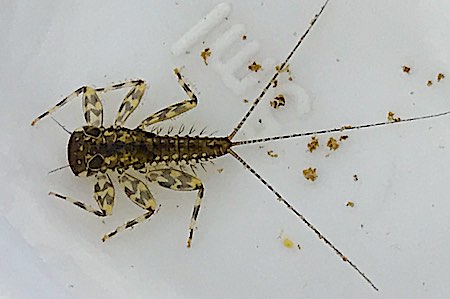
It’s distinguished from other stone-clinging nymphs by its broad legs with striped markings and the alternating light and dark markings on its three tails.
Its life cycle is similar to that of other up-winged flies:
- When the nymph is ready to hatch it crawls out from its underwater habitat and swims to the surface.
- On the journey to the surface, the dun emerges from its shuck and is ready to immediately leave the surface.
- It takes a day for the dun to mature into the spinner stage, and begin mating.
- Once mated, female spinners fly upstream and dip their abdomens onto the water at intervals to release a few eggs.
- Once the egg supply is finished, the spent female spinners drop onto the water and are washed downriver in foam lanes. In the evening, these spent flies are easiest for trout to seize.
Only when this stone-clinging nymph leaves the sanctuary of the riverbed to hatch are they available for trout to feed on.
The Yellow May Dun
The duns are an unmistakable sulphur yellow in colour. Its body is about 10 mm long, and the fly has two tails.
On the Welsh Dee, the main hatch starts in May and continues into July.
Adult flies typically emerge from mid-morning onwards, but on bright sunny days, most flies hatch at dusk.
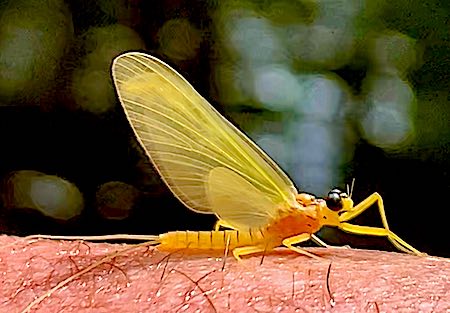
Yellow May Spinner
When the female dun transforms into the spinner stage its wings become transparent with dark veins. Whereas, the body remains bright yellow.
Once mated, the female spinners return to the water to lay their eggs early in the evening. After laying her eggs, the spent female fall onto the river and die.
The male spinners have darker bodies (almost amber colour) and only end up on the river on windy evenings. Consequently, rarely of interest to fly anglers.
Fishing for trout feeding on Yellow May Duns
You don’t have to turn many stones over in the riffle sections of the Welsh Dee to find plenty of Yellow May nymphs clinging to their surfaces.
Yet in 30 years of fishing the Welsh Dee, I can’t remember seeing a trout take the duns as they hatch during the day or catch a trout on one.
I suspect it’s because the river is often at its summer level and running crystal clear at this time of year and not because trout don’t like them.

In sunny, clear water conditions, trout have vacated the shallow riffle lies before mid-morning, and thus duns can hatch in safety.
It’s a different story when you have an evening hatch…
Brown trout go brusque for Yellow Mays…
Often ignoring any other fly until the hatch fades.
If you see the duns hatching during the day, it pays to stay until dusk to fish just below the riffle sections with a suitable emerger or dry fly pattern.
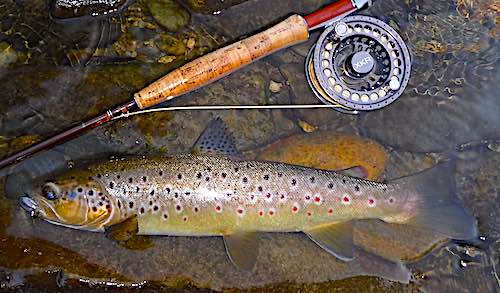
So, what Yellow May patterns do I fish…
Dry fly patterns:
I carry two dry fly patterns in my fly box. First up is a CDC emerger pattern, which I fish when there’s enough light to spot a dry fly being taken.
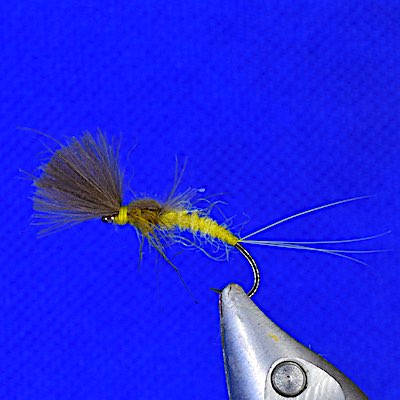
Yellow May CDC Emerger
- Hook: #14 Partridge 15BN Klinkhamer
- Thread: Yellow 8/0 Uni-Thread
- Tail: Yellow cock fibres
- Body: Yellow SLF dubbing
- Rib: 6/0 Yellow Uni-Thread
- Thorax: light olive seals fur sub.
- Wing: 3 CDC feathers (natural or dyed yellow)
On the rare occasions, the above emerger pattern fails, or it becomes too dark to follow the fly, I use a parachute pattern tied with a luminescent post.
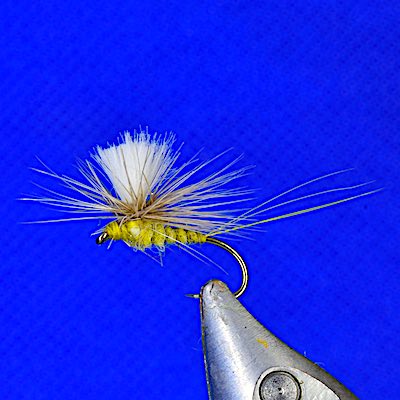
Parachute YMD – luminescent post
- Hook: Kamasan B402 (# 14 & 16)
- Thread: Yellow 8/0 Uni-Thread
- Wing Post: White GloYarm
- Tail: Yellow cock fibres
- Body: Yellow SLF dubbing
- Rib: 6/0 Yellow Uni-Thread
- Hackle: Medium Dun genetic cock
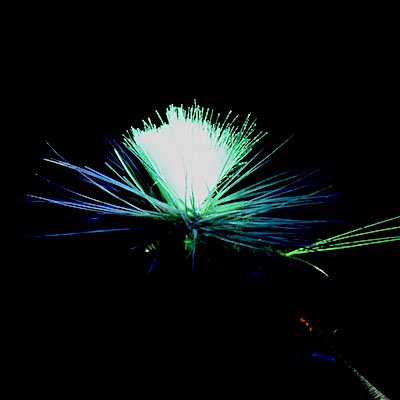
Once charged with a pocket torch, the luminescent post glows and makes the fly visible as the night sets in.
Wet fly pattern
After dusk, there are places on the river where it’s difficult to fish dry flies. In these areas, it is safer to fish wet flies across and downriver.
In that situation, I fish the following wet fly that is either fish it on its own or as the top dropper with two other wet flies or spider below it. This approach works well in the fast water at the heads of pools.
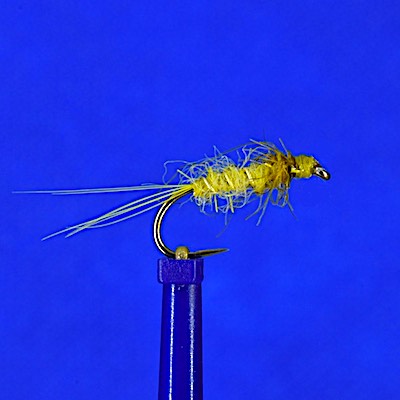
YMD wet fly
- Hook: Kamasan B402 (# 14 & 16)
- Thread: Yellow 8/0 Uni-Thread
- Tail: Yellow cock fibres
- Body: Yellow SLF dubbing
- Thorax: Light Olive seals fur
- Rib: fine gold wire
Equipment-wise for dry fly fishing and wet fly fishing…
I use a soft action 9ft 5# rod loaded with a floating line and a 12ft 5X copolymer leader for a single dry or wet fly set-up.
If I’m fishing a team of three flies, the leader is cut back to 7 ft from the but end. Then two 3 ft lengths of 3 lb copolymer are added to form 2 droppers.
I hope this article stimulates you to tie some of these fly patterns and test it on your local fishing location or take a trip to fish the Welsh Dee at Llangollen
Acknowledgements:
Finally, a kind thanks to Jonny Briggs for providing the wonderful photographs of the Yellow May Dun for this article.
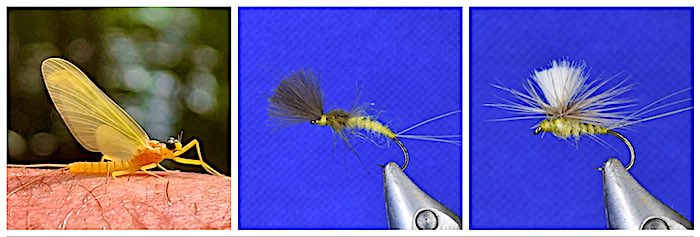
Really interesting piece Andrew , I don’t think I’ve ever seen a hatch of these flies and judging by the colour you couldn’t mistake them for anything else.
Hi James,
Great to hear you enjoyed the post. If you’re on the river when they are hatching you won’t miss them.
Their presence is a sign of very good water quality because they can’t tolerate pollution.
Cheers, Andrew
Great article again, l have had great success on R Dove fishing similar flies.. Didn’t know until know what they were called, caught them on the water and used a fly close in appearance.
Hi Steve,
They are beautiful flies and a lovely sight on the river because it’s a sign summer is on the way and the river is in good health.
Cheers, Andrew
Yellow May Duns were hatching on Sunday lower down the river, not enough for the trout to really switch on to them but enough to notice
Hi Andy,
Good to hear you have seen a few coming off. Often the best hatches occur on warm evenings (as the light starts to fade) at Llangollen and the trout and grayling won’t take anything else.
Andrew
Andrew, this is my first summer at tying flys and your articles are a fantastic resource for me.
Hi Phil,
Great to hear you are finding the articles very helpful.
Cheers, Andrew
Very interesting article as usual like all the others have you thought about putting them all into a book.
Hi Keith,
Great to hear you enjoyed the article. Maybe a book one day.
Cheers, Andrew
Hi Andrew, firstly thanks for the advice you provided re: the Llangollen stretch. My pal and myself fished it recently and both agreed what a wonderful stretch of river.
These kinds of posts are truly helpful to me in identifying the natural and tying an imitation – thanks ever so much!
Steve Holden
Hi Steve,
Great to hear you enjoyed fishing the Dee at Llangollen and that my post have been helpful.
Tight lines, Andrew
Hi Andrew, really enjoying the blog articles, I subscribed a short while ago. My first full season of fly fishing the Dee and Ceirog, also tying my own flies now too. So each article gives me a great incentive to learn how to tie the various patterns at the right season and then get out for a session. Learning so much, might even catch something eventually! Cheers, Pete
Hi Pete,
Pleased to hear that you are enjoying the blog articles and finding them useful and informative.
Tight lines, Andrew
Andrew – like you, I’ve never seen a Trout or Grayling take a Dun on the Dee.
Brilliant Blog as always – you should definitely make these into a book.
On the Dee I don’t think the hatch is intense enough to get the fish interested in the dry flies. However, nymphs and emerges seem to work well.
Tight lines, Andrew
Thanks for sharing your knowledge. Very interesting.
Great to hear you enjoyed it.
Tight lines, Andrew